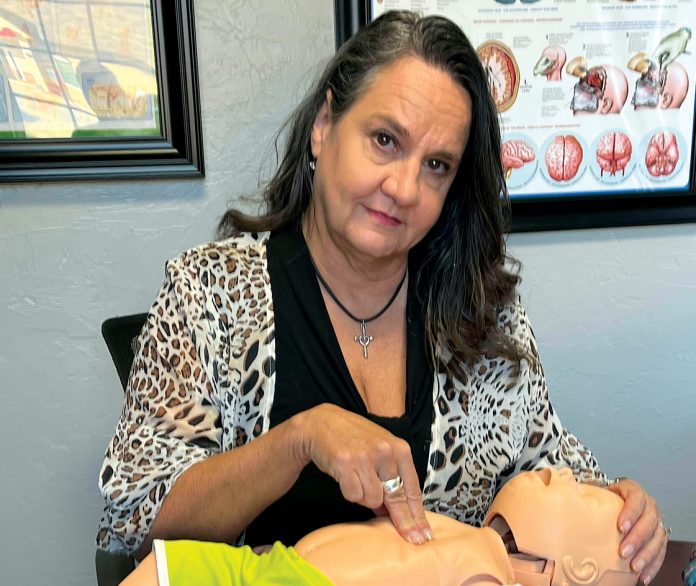
Proper training makes all the difference
story and photo by James Coburn, Staff Writer
Heartland CPR, LLC has indirectly saved thousands of lives by teaching people basic life support.
“I think it’s pretty special,” said Ginger Davis, owner of Heartland CPR, LLC with training located in Oklahoma City. “We have a lot of people come back to us and tell us, ‘Hey, I was just learning this for work and the day after training, my wife choked at dinner.’”
Davis collects those life-saving stories to share on social media.
“If you ever wonder if what you’re doing is making a difference, those kind of stories tell you that it is,” Davis said. (story continues below)
She started the business 20 years ago. Her husband Brian Davis serves as the assistant fire chief of the Emergency Medical Services division for the City of Edmond.
Any professional healthcare worker is mandated by the state to have basic life support (BLS) training. More than 3500 customers learn life saving measures at Heartland CPR. Sixty percent of her clientele are nurses. Another course is available for people who don’t have the benefit of advanced medical education. The classical heart-saver course is targeted toward workers in construction, oil field, daycare, and others. People often take a course because their job requires it. But most people use life support on their own family members.
Several minor changes and two significant changes have occurred since Ginger Davis founded the business in 2003. Verbal feedback mannequins are required to be compliant for CPR regarding depth and speed of technique. There are differences in giving CPR to a baby, she said.
“If it’s your own baby and you’re doing mouth-to-mouth, there’s a few things you can do like over the nose and mouth both with your mouth to keep that from escaping,” Davis said. “If it’s not your baby and you want to use barrier devices, you have to pinch the nose, but use a lot less air.”
BLS works differently when two people work to save a child or infant. That is because cardiac arrest for infants and children almost always involves an airway issue, Davis explained.
“They’re choking or there’s a problem with their breathing,” Davis said.
A heart condition usually causes cardiac arrest for an adult. So, BLS involves giving 30 compressions and two breaths. An infant or a child needs to be given twice as many breaths in the same period, Davis said.
With two people working, one breathes into the child or infant’s airway and the other one does the compressions. This technique provides twice the air for an infant opposed to the adult process.
It’s important to open the airway with a head tilt chin lift or the air won’t go in, she said.
To regain heart rhythm, Davis interlocks her fingers for compressions given directly on the middle of the chest.
“The heart is in the middle, so by going straight to the middle (the heart is) almost like compressing a sponge. You’re clipping the edge of that sponge and that sends the blood out to all the different places, especially the brain.”
She cautions not to be afraid to press too hard when giving life support to the heart, simply because a possible broken rib is minor compared to death, Davis said.
“The prime area to go in a child is one-third to one-half the chest. In an adult, we pretty much go a straight 2 inches because that will pretty much get you to the heart,” Davis explained.
Persons uncomfortable with mouth-to-mouth resuscitation, especially due to COVID, should know the benefit of continuing with hands-on compression CPR, Davis said.
“If they’re a stranger, you might not want to put your mouth on them, not knowing their health history, but that will still keep the oxygen in the blood flowing until EMS can get there,” she continued.
It’s important not to be dissuaded to discontinue life support if emergency services seem slow in arriving to help, she cautioned. Multiple accounts verify that people have survived cardiac arrest after multiple shocks from an automated external defibrillator.
Davis said because colleges went to online learning due to COVID, that people mistakenly believe that CPR can be learned online. This is not the case.
“Without a practice component, it’s not something that you can be proficient at,” she said. “But a lot of people are fooled that you can do that, and they pay a lot of money, they’ll get a certification and try to turn it in at work, and they’re told this isn’t real; this is an online scam,” Davis said.
A lot of businesses don’t know the questions to ask when they’re given a card stating someone is properly trained in CPR. She would like to see more education about the need for practicing CPR.
Additionally, people need refresher courses, Davis said. The American Heart Association recognizes two years is the limit for a refresher course after a two-year certification.
Heartland CPR teaches at its office or will go on location.
“We love that. If you have a group of eight or more, we will go to your location and teach your staff together.”












